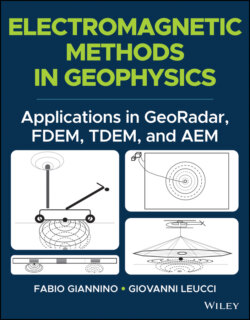Читать книгу Electromagnetic Methods in Geophysics - Fabio Giannino - Страница 15
2 Electromgnetic (EM) Theory: An Outline 2.1. GROUND PENETRATING RADAR (GPR): OPERATIVE PRINCIPLES AND THEORY 2.1.1. General
ОглавлениеThe Ground Penetrating Radar (GPR), also known as Georadar is one of the most widely accepted and used geophysical methods for the exploration of the shallow subsurface, especially but not limited to civil engineering, geological studies, utility mapping, environmental, or archaeological applications. Its ability to provide, easily and quickly, high‐resolution and continuous information on the uppermost few meters (up to tens of meters) of the natural or man‐made surface, heavily contributed to the increasing popularity of this method and to its expanding role among the shallow geophysical techniques in the last two decades. Nevertheless, the same reasons could make this method highly subjected to misuse.
For a successful application of the GPR technique, as well as any other methods for underground mapping, it is necessary not only to understand its fundamental principles, but also its general characteristics and limitations in relation to the practical application for which it is required its deployment on site; this information, addresses the user to develop suitable field and post‐acquisition procedures for the specific problem at hand.
Dissertation on the theoretical basis, practical guidelines, as well as numerous case histories on GPR studies in various fields of applications, can be found in recent literature, such as books (Leucci, 2019; Conyers, 2004; Conyers, 2013), geophysical handbooks (Campana and Piro, 2008; Reynolds, 2011; Persico et al., 2018), Proceedings and Special Issues of geophysical journals (as those devoted to the biennial International Conference on GPR held since 1986), and numerous research papers.
Although in earlier times GPR data were generally used and interpreted as they were collected (the so‐called raw data), they are now routinely subjected to digital data‐processing, interpretation, and display techniques aiming to further enhance the visibility of meaningful signals in the raw data, and to help in understanding their three‐dimensional relationships. Due to the close kinematic similarity with seismic reflection methods, most of the processing and visualization techniques currently available in GPR processing software are a direct adaptation of the seismic ones.
The physical bases and mathematical foundations underlying these techniques are therefore available from seismic literature (Yilmaz, 1987) and most recently Persico, 2014. Nevertheless, although without presuming to furnish a deep examination and an exhaustive treatment of the theoretical and practical aspects of the GPR method, the main basic principles underlying the acquisition and processing of GPR data, needed for the comprehension of the tasks faced in the next chapters, are concisely exposed in the following pages.
